The following is a transcript of the presentation videos, edited for clarity.
What Is a Research Plan, and Why Do You Need One?
Presented by Cathy Binger
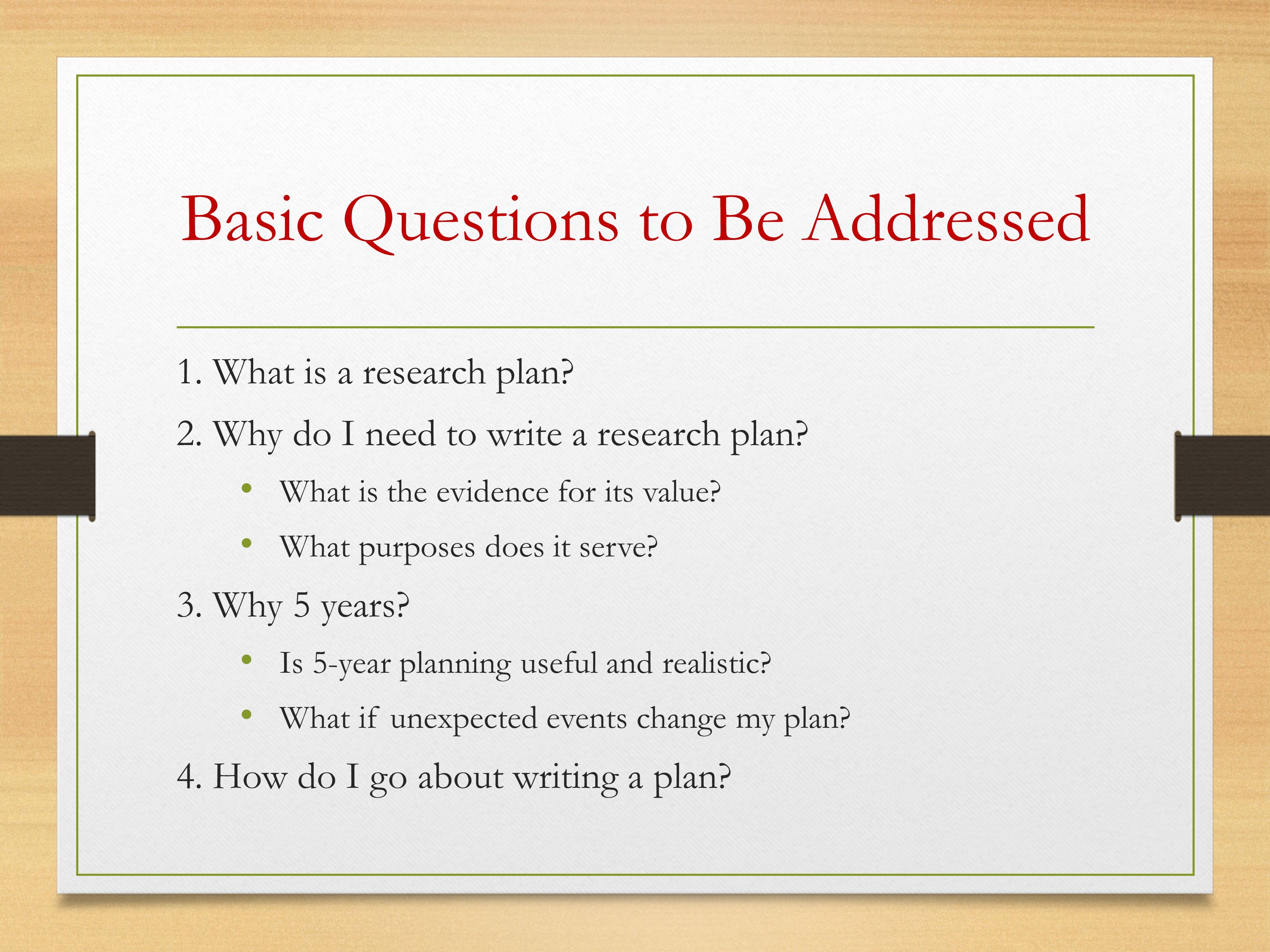
First we’re going to talk about what a research plan is, why it’s important to write one, and why five years—why not one year, why not ten years. So we’ll do some of those basic things, then Liza is going to get down and dirty into the nitty-gritty of “now what” how do I go about writing that research plan.
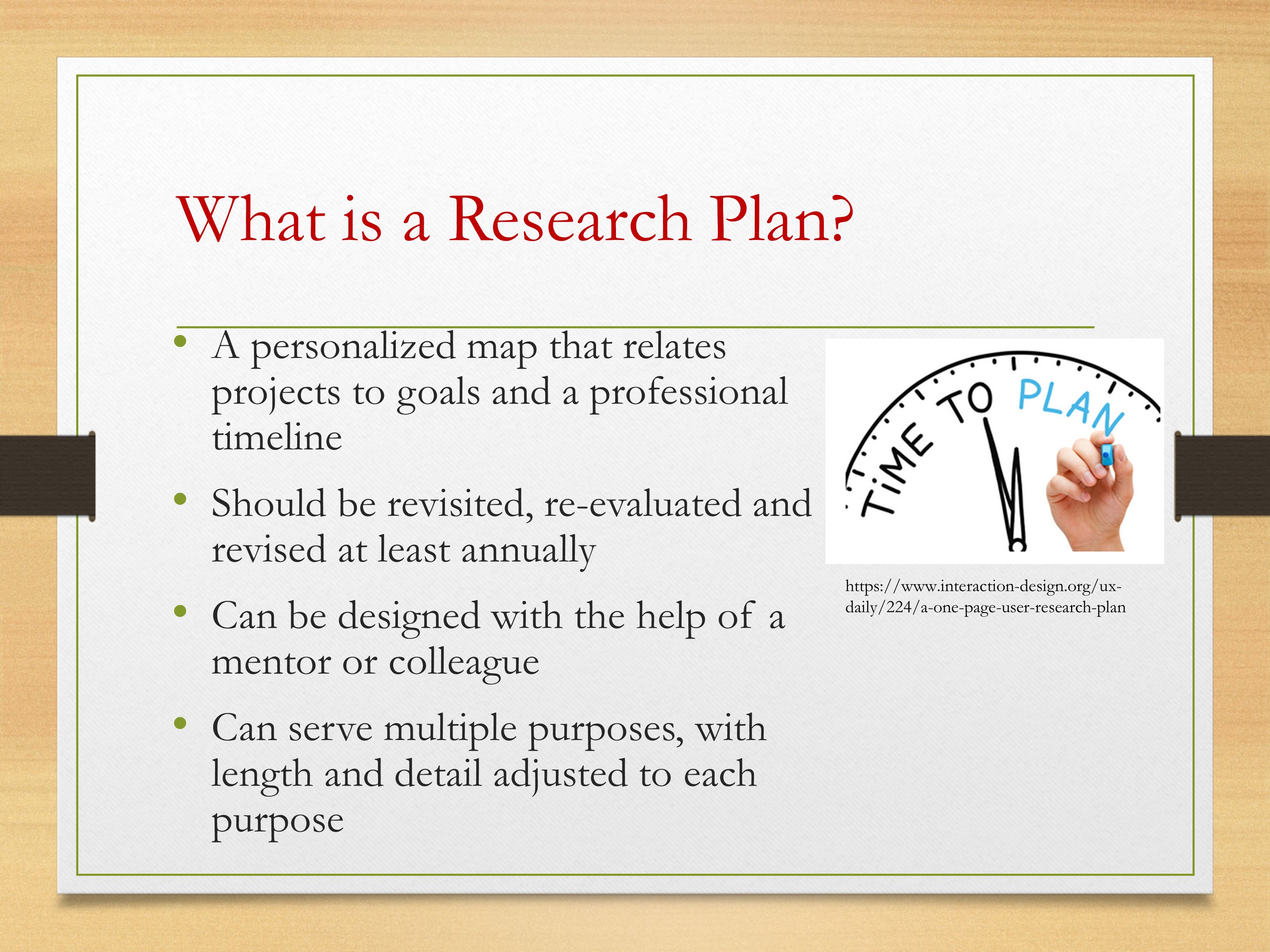
First of all, what is a research plan? I’m sure some of you have taken a stab at these already. In case you haven’t, this is a real personalized map that relates your projects to goals. It’s exactly what it sounds like, it’s a plan of how you’re going to go about doing your research. It doesn’t necessarily just include research.
It’s something that you need to put a little time and effort into in the beginning. And then, if you don’t revisit it, it’s really a useless document. It’s something that you need to come back to repeatedly, at least annually, and you need to make it visible. So it’s not a document that sits around and once a year you pull it out and look at it.
It can and should be designed, especially initially, with the help of a mentor or colleague. And it does serve multiple purposes, with different lengths and different amounts of detail.
I forgot to say, too, getting started, the slides for this talk were started using as a jumping off point Ray Kent’s talk from last year. So some of the slides we’ve borrowed from him, so many thanks to him for that.

But why do we want to do a research plan? Well, to me the big thing is the vision. Dr. Barlow talked this morning about your line of research and really knowing where you want to go, and this is where that shows up with all the nuts and bolts in place.
What do you want to accomplish? What do you want to contribute? Most of you are at the stage in your career where maybe you have started out with that you want to change the world scenario and realized that whatever you wanted your first research project to be, really, is your entire career. You need to get that down to the point where it is manageable projects that you can do—this is where you map out what those projects are and set reasonable timelines for that.
You want to really demonstrate your independent thinking and your own creativity, whatever that is that you then establish as a PhD student, postdoc, and beyond—this is where you come back to, okay, here’s how I’m going to go about achieving all of that.
This next point, learning to realistically gauge how long it takes to achieve each goal, this for most of us is a phenomenally challenging thing to do. Most of us really overestimate what we can do in a certain amount of time, and we learn the hard way that you can’t, and that’s another reason why you keep coming back to these plans repeatedly and learning over time what’s really manageable, what’s really doable, so we can still reach our goals and be very strategic about how we do that.
When you’re not strategic, you just don’t meet the goals. Your time gets sucked into so many different things. We need to be really practical and strategic.
Everything we do is going to take longer than we think.
I think this last one is something that maybe we don’t talk about enough. Really being honest with ourselves about the role of research in our lives. Not all of you are at very high-level research universities. Some of you have chosen to go elsewhere, where research maybe isn’t going to be playing the same role as it is for other people. The research plan for someone at an R One research intensive university is going to look quite different from someone who is at a primary teaching university. We need to be open and practical about that.
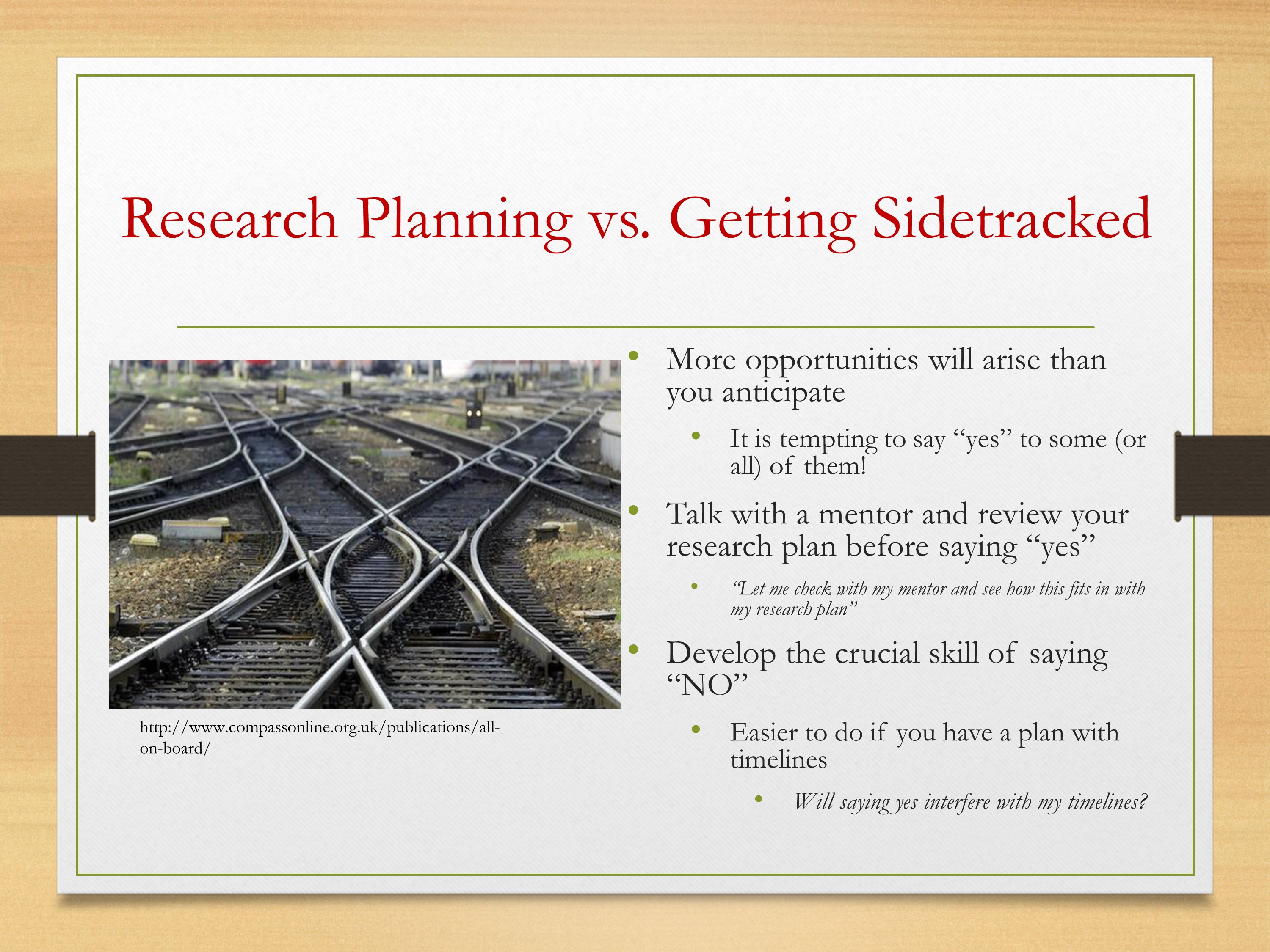
Getting sidetracked. I love this picture, I just found this picture the other day. This feels like my life. You can get pulled in so many different directions once you are a professor. You will get asked to do a thousand different things. There are lots of great opportunities that are out there. Especially initially, it’s tempting to say yes to all of them. But if you’re going to be productive, you have to be very strategic. I’m going to be a little bit sexist against my own sex here for a minute, but my observation has been that women tend to fall into this a little bit more than men do in wanting to say yes and be people pleasers for everything that comes down the pike.
It is a professional skill to learn how to say no. And to do that in such a way that you are not burning bridges as you go down the path. That is a critical skill if you are going to be a successful researcher. I can’t tell you how many countless people I’ve seen who are very bright, very dedicated, have the skills that it takes in terms of doing the work—but then they are not successful because they’ve gotten sidetracked and they try to be too much of a good citizen, give too much service to the department, too much “sure I’ll take on that extra class” or whatever else comes down the line.
I just spoke with a professor recently who had something like five hours a week of office hours scheduled every single week for one class. Margaret is shaking her head like “are you kidding?” That’s crazy stuff. But he wanted to really support his students. His students loved him, but he was not going to get tenure. That’s the story.
So we have to be very thoughtful and strategic, and what can help you with this, and ASHA very firmly recognizes which is why we’re here—is that your mentors in your life should be there to help you learn these skills and learn what to say yes to, and learn what to say no to. I’ve learned to say things like, “Let me check with my mentor before I agree to that.” And it gives you a way out of that. The line that I use a lot is, “Let me check with my department head” or, I just said this to somebody last week, “I just promised my department head two weeks ago that I would only do X number of external workshops this year, so I’m going to have to turn this one down.” Those are really important skills to develop.
And having that research plan in place that you can go back to and say, know what, it’s not on my plan I can’t do it. If I do it—I have to go back to my research plan and figure out what I’m going to kick off in order to review this extra paper, in order to take on this extra task. The plan also helps me to know exactly what to say no to. And to be very direct and have a very strong visual.
I actually have my research plan up on a giant whiteboard in my office, so I can always go back to that and see where I am, and I can say, “Okay, what am I going to kick off of here? Nothing. Okay, I have to say no to whatever comes up.” Just be strategic. This is where I see most beginning professors really end up taking that wrong fork in the road—taking that right instead of that left, and ending up not being the successful researcher that they wanted to be.
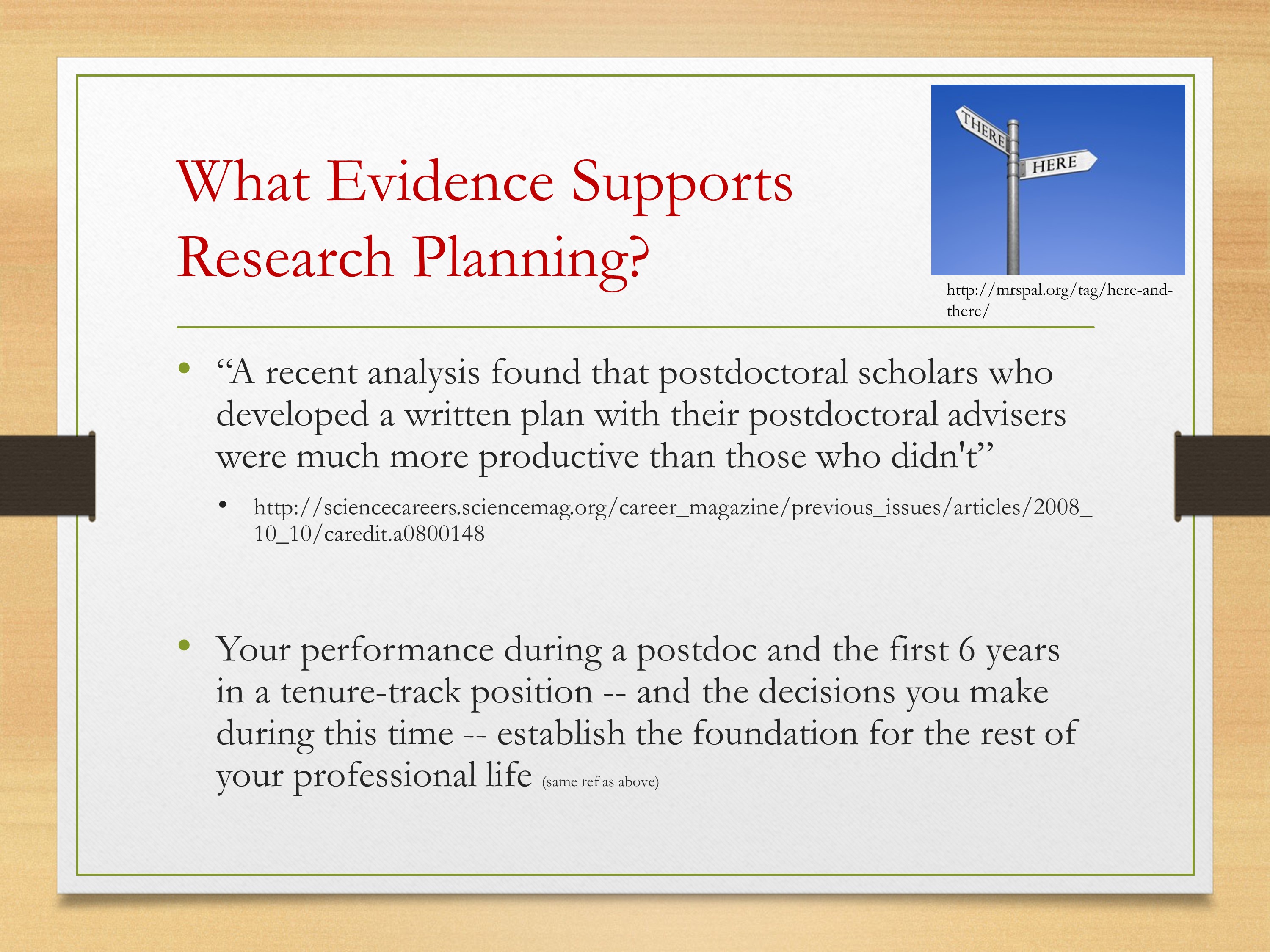
What evidence supports research planning? This was something Ray Kent had found. That a recent analysis had found that postdoc scholars who developed a written plan with their postdoc advisers were much more productive than those who didn’t. And your performance during a postdoc—and I know many of you have either finished your postdoc or decided not to—so more simply, just during those first six years, the decisions you make really do establish the foundation for the rest of your professional life. It’s very important to get started and get off on the right foot.

I love this quote, I just found it the other day: “Productivity is never an accident. It is always the result of a commitment to excellence, intelligent planning, and focused effort.”
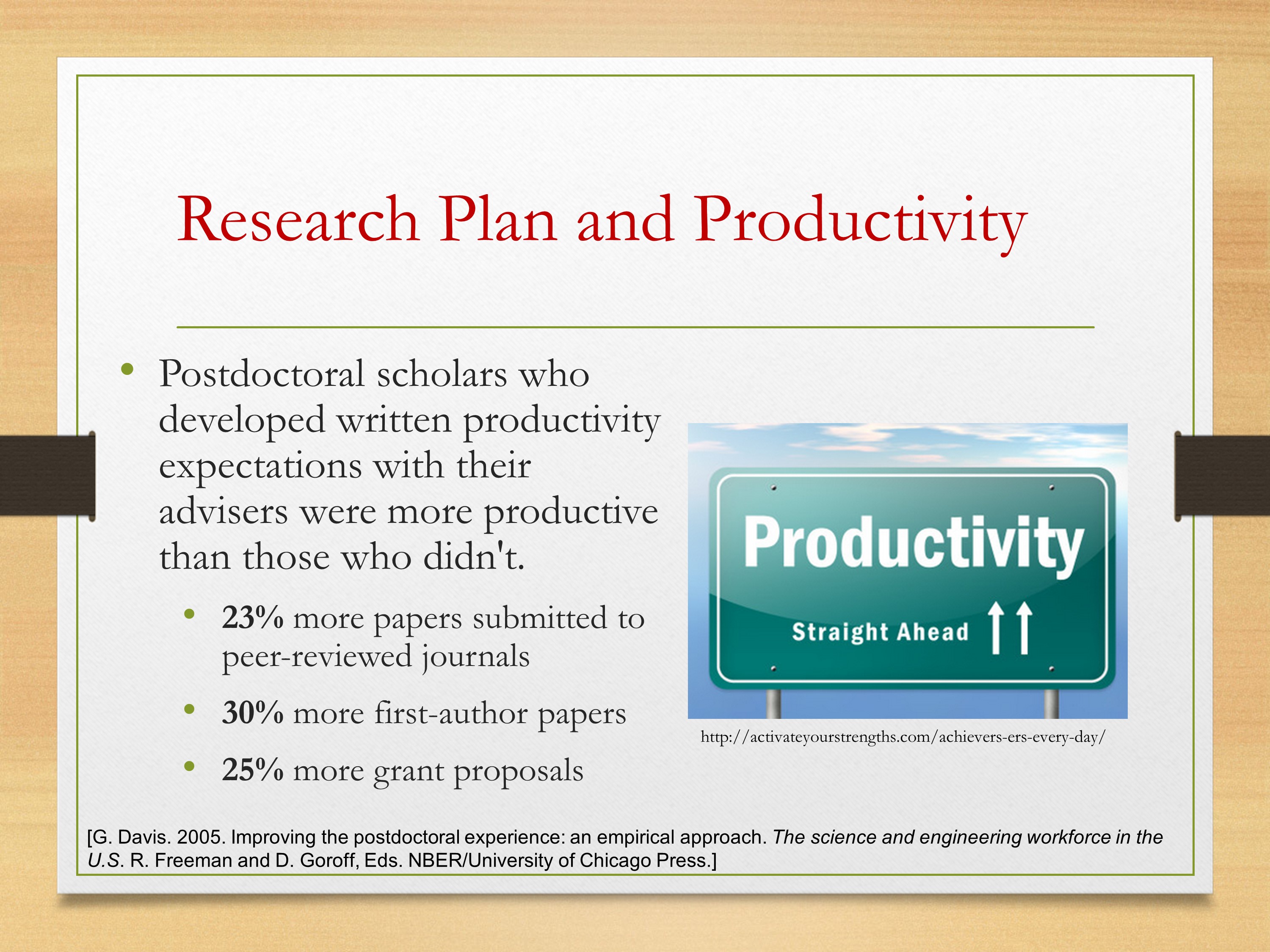
What we see with productivity is that postdoc scholars who developed written productivity expectations with their advisers were more productive than those who didn’t. You see 23% more papers submitted, 30% more first-author papers, and more grant proposals as well.

So why five years? I’m going to start with number 5. It’s long enough to build a program of research, but short enough to deal with changing circumstances. That’s really the long and the short of the matter. As well as these other things as well that I won’t take the time to go through point by point.
What Should a Five-Year Plan Include?
Presented by Lizbeth Finestack

So, thinking about a five-year research plan, I like to think about it like your major “To Do List.” It’s what you’re going to accomplish in five years. Start thinking: What is going to be on my to do list?
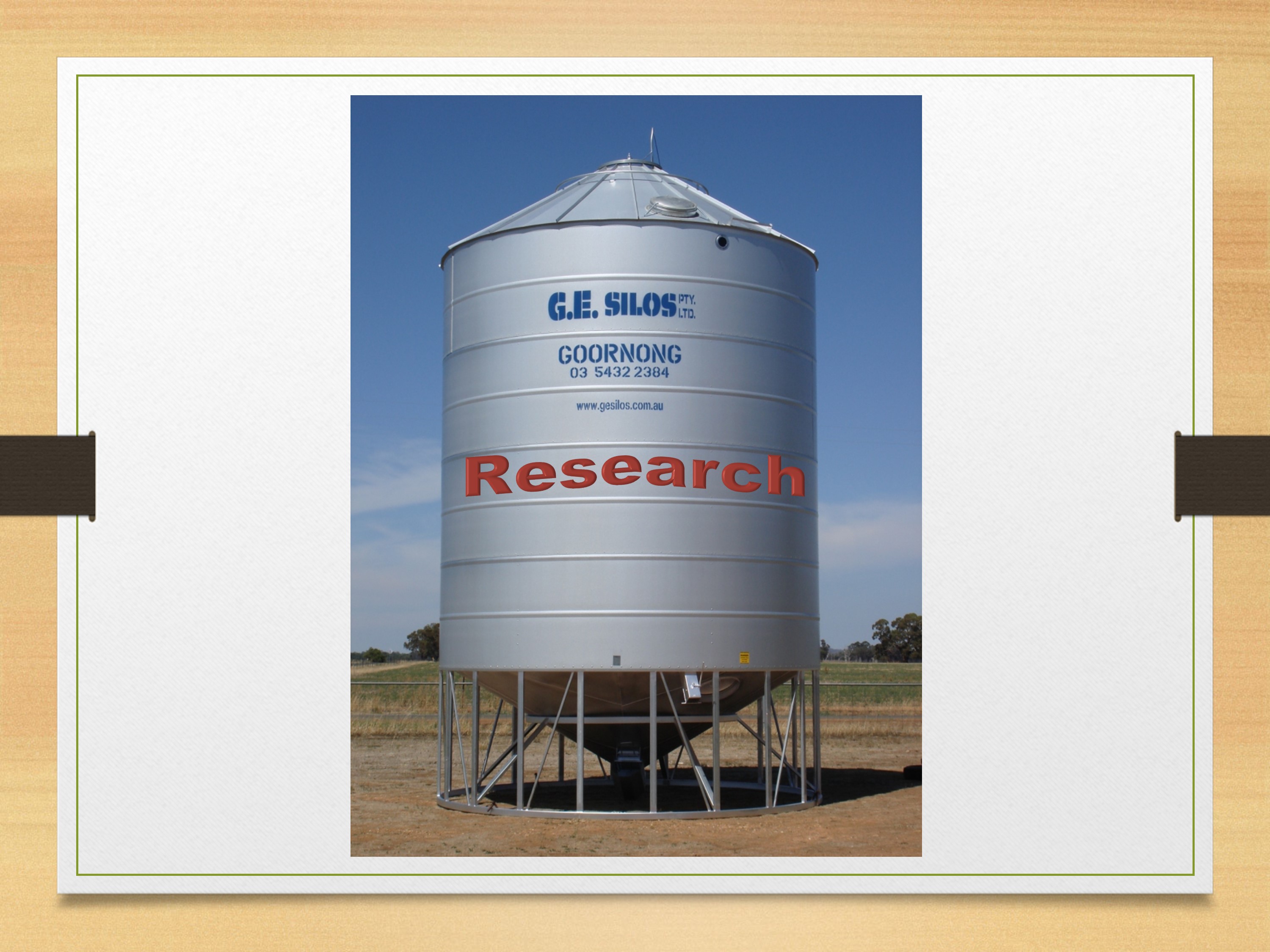
You can also think about it like: Okay, I have research. I’ve got to do research. Maybe think about this as one big bucket, or maybe one humongous silo. I have some farm themes going on. Cathy was just on a farm, so I thought I’d tie that in.
So here’s your big silo. You can call that your research silo.

But more realistically, you need to think about it like separate buckets, separate silos, where research is just one of those. Just like Cathy indicated, there’s going to be lots of other things coming up that you’re going to have to manage. They are going to have to be on your to do list, you need to figure out how to fit everything in.
What all those other buckets or silos are, are really going to depend on your job. And maybe the size of the silos, and the size of the buckets are going to vary depending on where you are, what the expectations are at your institution.
That’s important to keep in mind, and Cathy said this too, it’s not going to be the same for everyone. The five-year plan has to be your plan, your to do list.

Here are some buckets or some silos that I have on my list and the way that I break it up, this is just one example, take it or leave it.
The first three are all very closely related, right? Thinking about grants, thinking about research, thinking about publications. I’m going to define grants as actual writing, getting the grant, getting the money.
Research is what you’re going to do once you get that money. Steps you need to take before you are getting the money. Any sorts of projects, the lab work, that’s why I have the lab picture there. Of course, publications are part of the product—what’s coming out of the research—but it also cycles in because you need publications to support that you are a researcher to apply for funding and show you have this line of research that you’ve established and you’ll be able to continue. So, those first three are really closely related. And that’s where I’ll go next. And then have teaching and service you see here at the bottom.
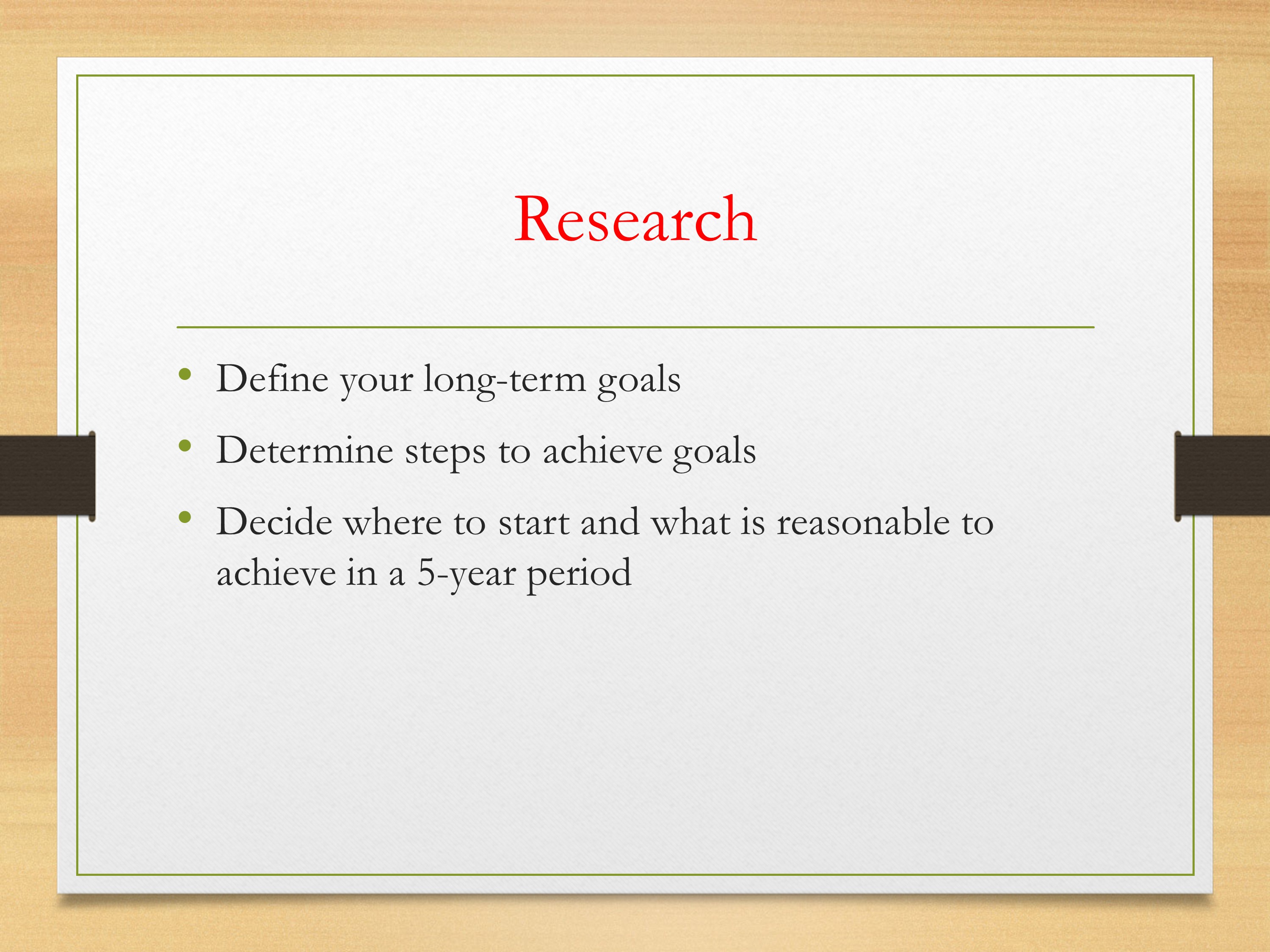
So thinking about research, in that broad sense. As you’re writing your five-year plan you’re going to want to think of, “What’s my long-term goal?” There’s lots of ways to think of long-term goals. You could think, before I die, this is what I want to accomplish. For me I kind of have that. My long-term goal is that I’m going to find the most effective and efficient interventions for kids with language impairment. Huge broad goal. But within that I can start narrowing it down.
Where am I within that? Within the next five years or maybe the next ten years, what is it I want to accomplish towards that goal. Then start thinking about: In order to accomplish that goal, what are the steps I need to take? Starting to break it down a little bit. Then it’s also going to be really important to think: where are you going to start? Where are you now? What do you need to have happen? And is it reasonable to accomplish this goal within five years? Is it going to take longer? Maybe you could do it in a couple years? Start thinking about the timeline that’s going to work for you.

Then thinking about your goals—and everyone’s program is going to be different, like I said, there’s going to be a lot of individual needs, preferences. So it might be the case that you have this one long-term goal that you’re aiming for. Long-term goal in the sense of, maybe, what you want to study in your R01, perhaps something like that. But in order to get to that point, you’re going to have several short-term goals that need to be accomplished.
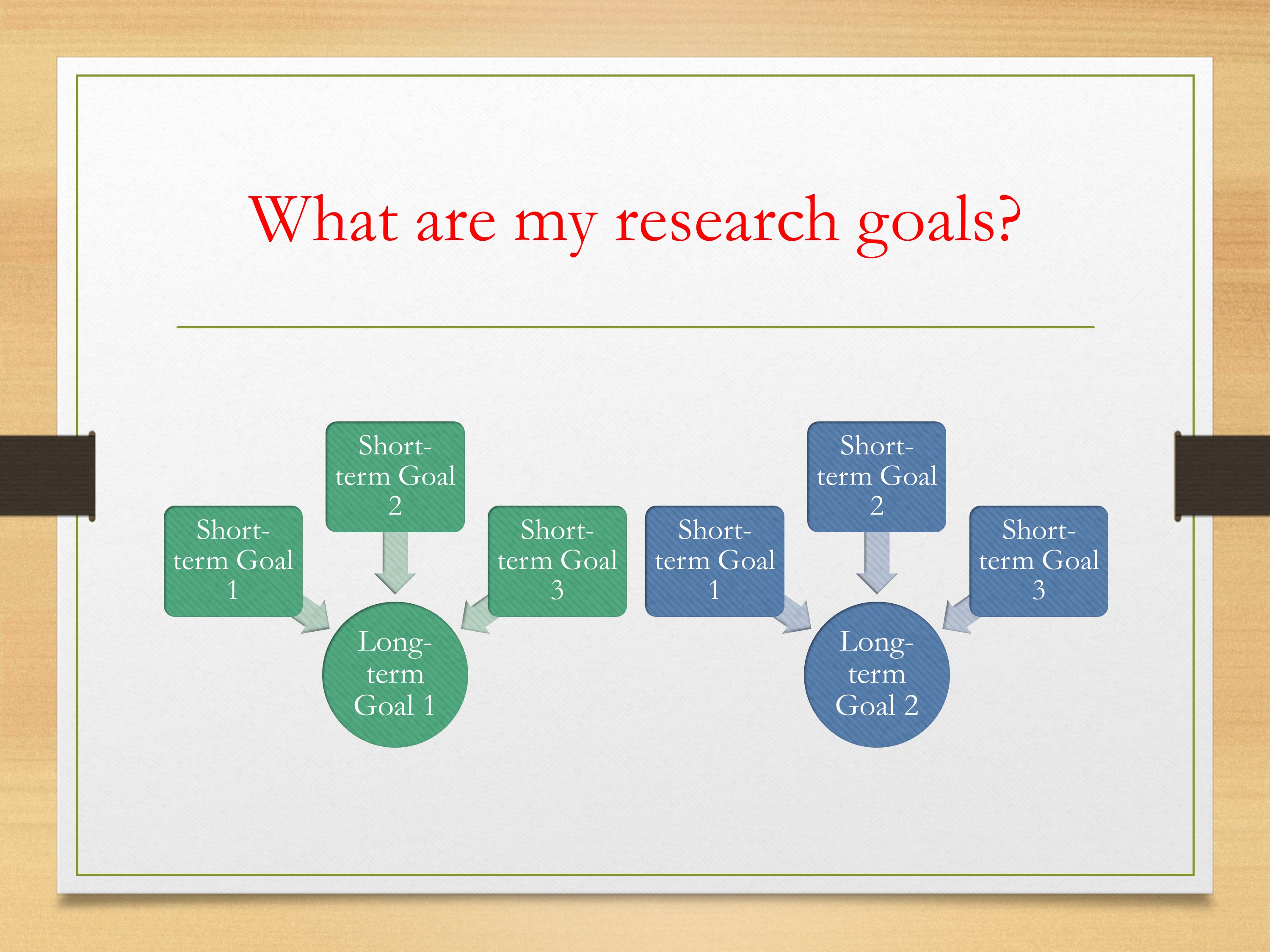
Or maybe it’s the case that you have two long-term goals. And with each of those you’re going to have multiple short-term goals that you’re working on. Maybe the scope of each of these long-term goals is a little bit less than in that first scenario.
Start thinking about my research, what I want to do, and how it might fit into these different circumstances.

Also thinking about your goals, this is a slide from Ray Kent from last year, was thinking about the different types of projects you might want to pursue, and thinking about ones that are definitely well on your way. They are safe bets. You have some funding. They are going to lead directly into your longer-term plan.
Those are going to be your front burner—things you can easily focus on. That said, don’t put everything there.
You can also have things on the back burner. Things that really excite you, might have huge benefits, big pay. But you don’t want to spend all of your time there because they could be pretty risky.
Start thinking about where you’re putting your time. Are you putting it all on this high-risk thing that if it doesn’t pan out you’re going to be in big trouble? Or balancing that somewhat with your front burner. Making that steady progress that will lead directly to help fund an R01 or whatever the mechanism that you’re looking for.
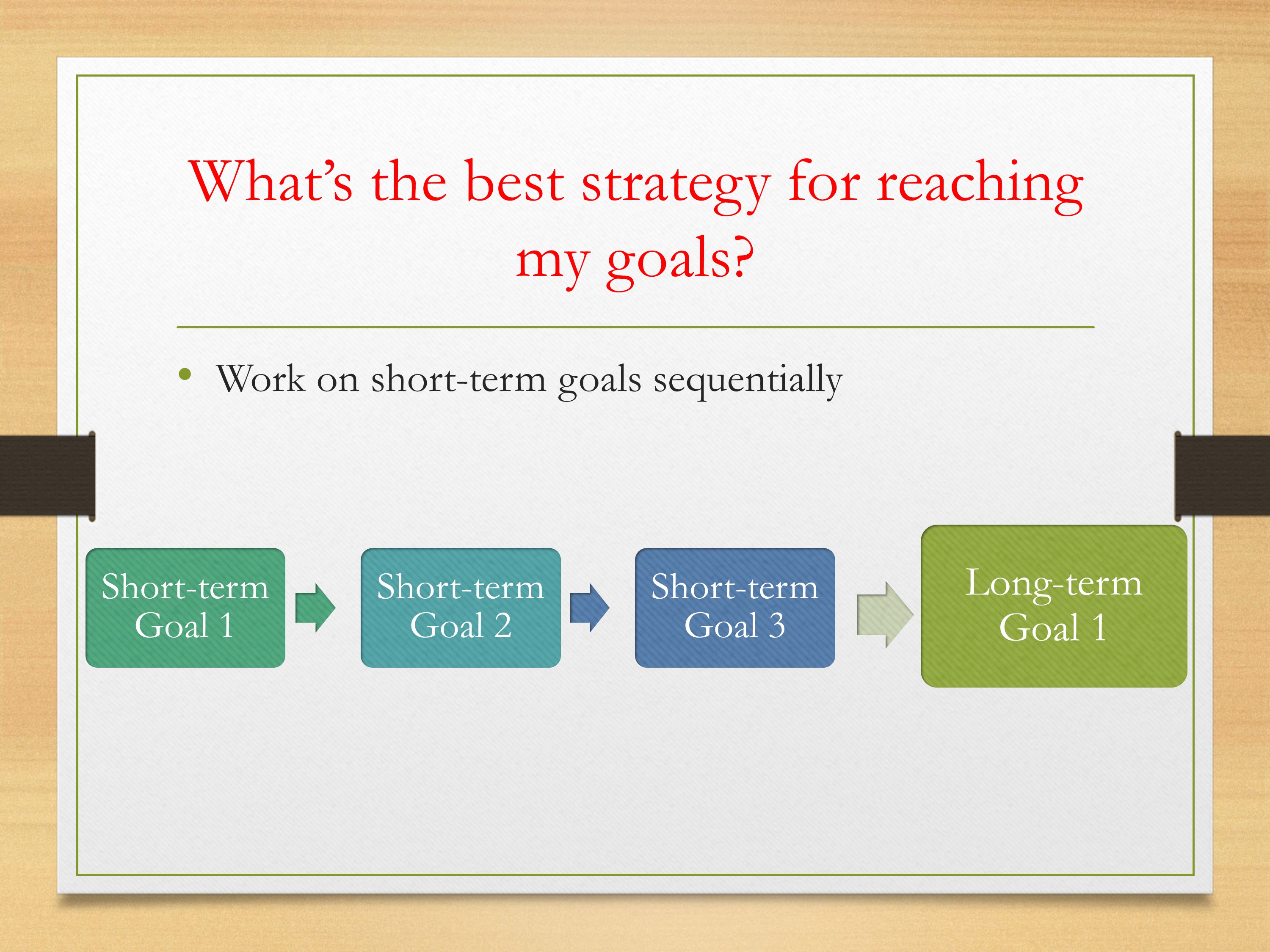
Then, thinking about your goals—if you have multiple long-term goals, or thinking about your short-term goals, you could think about your process.
Is it something where you need to do study 1 then study 2, then study 3—each of those building on each other, that’s leading to that long-term goal. In many cases, that is the case, where you have to get information from the first study which is going to lead directly to the second study and so forth.
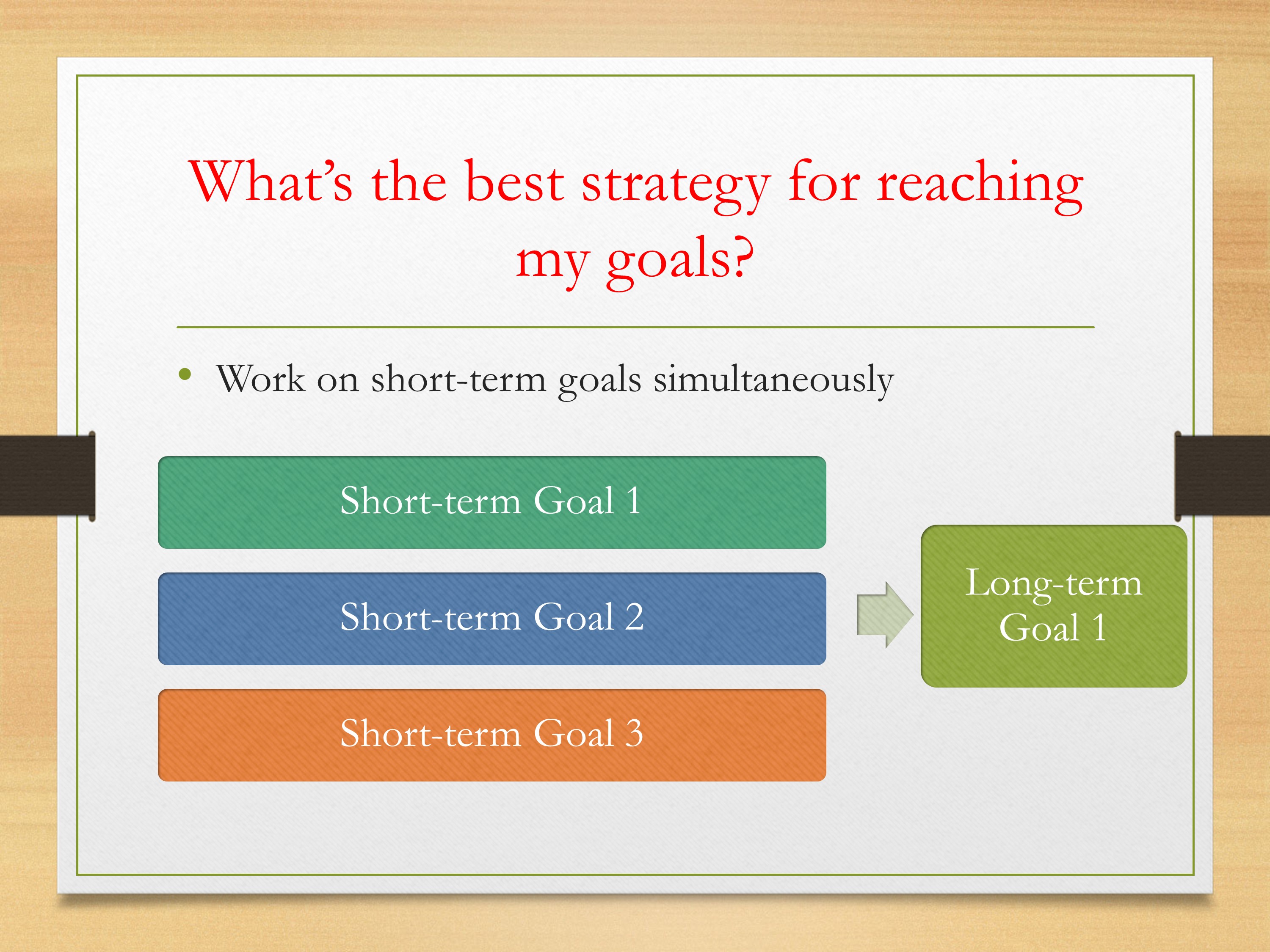
Or is it the case that you can be working on these three short-term goals simultaneously? Spreading your resources at the same time. Maybe it will take longer for any one study, but across a longer period of time you’ll get the information that you need to reach that long-term goal.
Lots and lots of different ways to go about it. The important thing is to think about what your needs are and what makes the most sense for you.

Here’s my own little personal example. Starting over here, I have my dissertation study. My dissertation study was this early efficacy study looking at one treatment approach using novel forms that really can’t generalize to anything too useful, but it was important.
Then I did a follow up study, where I was taking that same paradigm, looking to see where kids with typical development perform on the task. So I have these two studies, and they served as my preliminary studies for an R03. So I just finished an R03 where I was looking at different treatment approaching for kids with primary language impairment. At the same time, while conducting my R03, I’m also looking at some different approaches that might help with language development. Also conducting surveys to see what current practices are.
I have these three projects going on simultaneously, that are going to lead to a bigger pilot study that are going to feed directly into my R01. All of this will serve as preliminary data to go into an R01.
Start thinking about your projects, what you have. Maybe starting with your dissertation project or work that you’re doing as a postdoc as seeing how that can feed into your long-term goal. And really utilizing it, building on it, to your benefit.
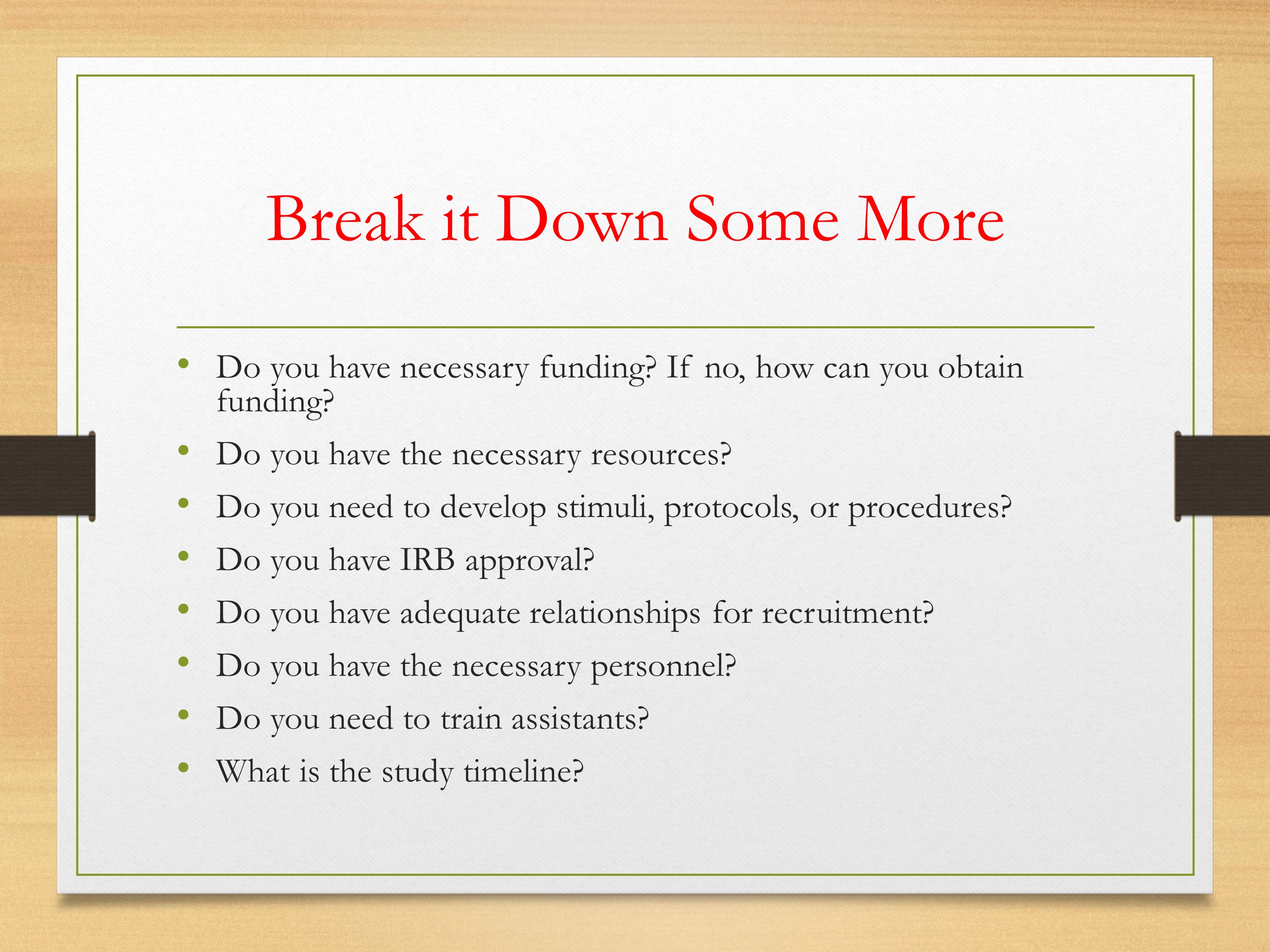
That’s all fine and dandy. You can draw these great pictures. But you still have to break it down some more. It’s not like, “Oh, I’m just going to do this project.” There are other steps involved, and lots of the time these steps are going to be just as time consuming.
Starting to think about: well, if you have the funding. Saying, “I want to do this study, but I have no money to do it.” What are the steps in order to get the money to do it? Do you have a pilot study? What do you need?
Start thinking about the resources? Do you need to develop stimuli, protocols, procedures? Start working on that. All of these can be very time consuming, and if you don’t jump on that immediately, it’s going to delay when you can start that project.
Thinking about IRB. Relationships for recruitment, if you’re working with special populations especially? Do you have necessary personnel, grad students, people to help you with the project? Do you need to train them? What’s the timeline of the study?
Start thinking about all these pieces, and how they are going to fit in that timeline.
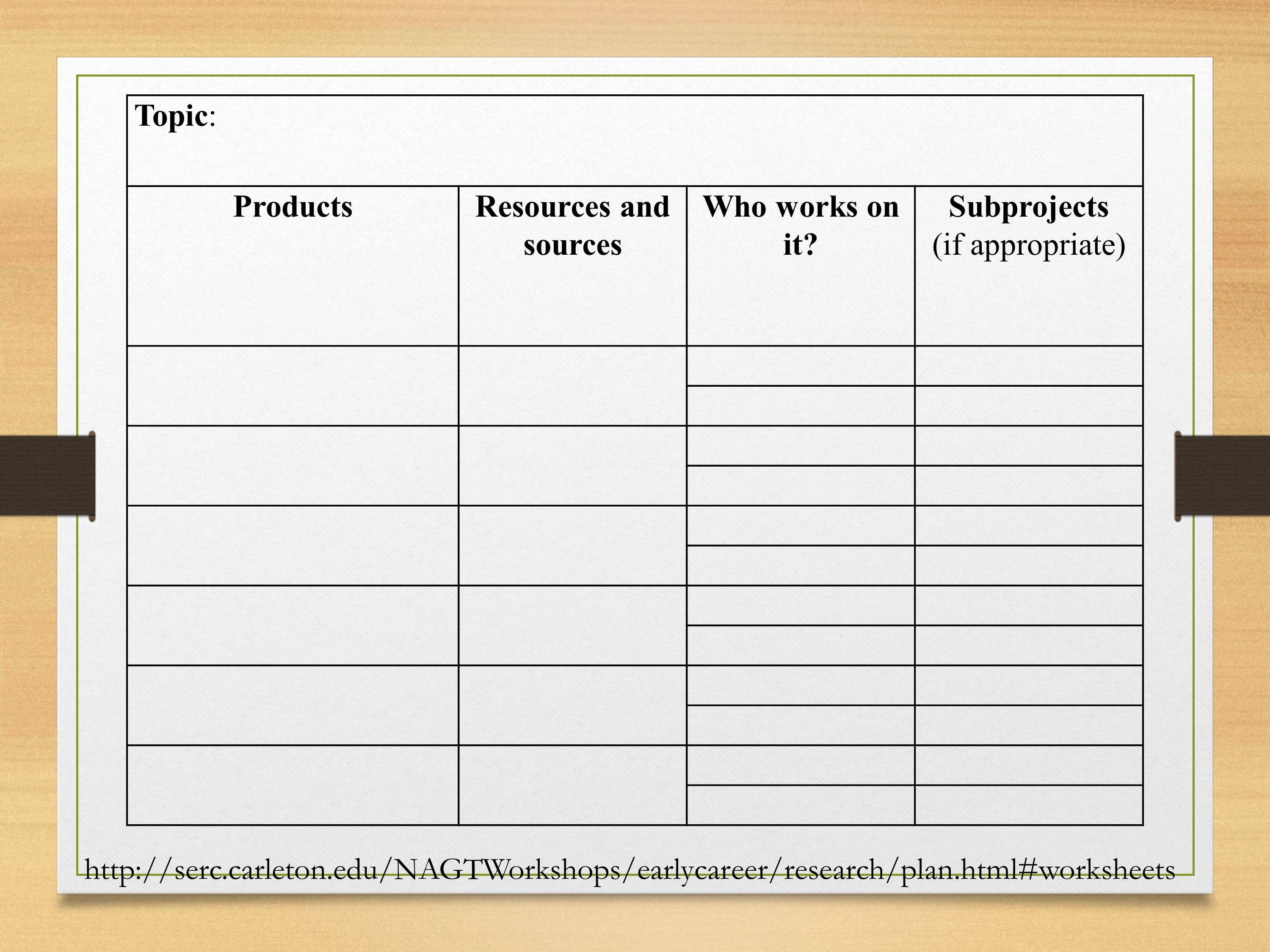
This is one way that might help you start thinking about the resources that you need. This is online—Ray Kent had it in his talk, and when I was doing my searches I came across it too and I have the website at the end. Just different ways to think about the resources you might need.
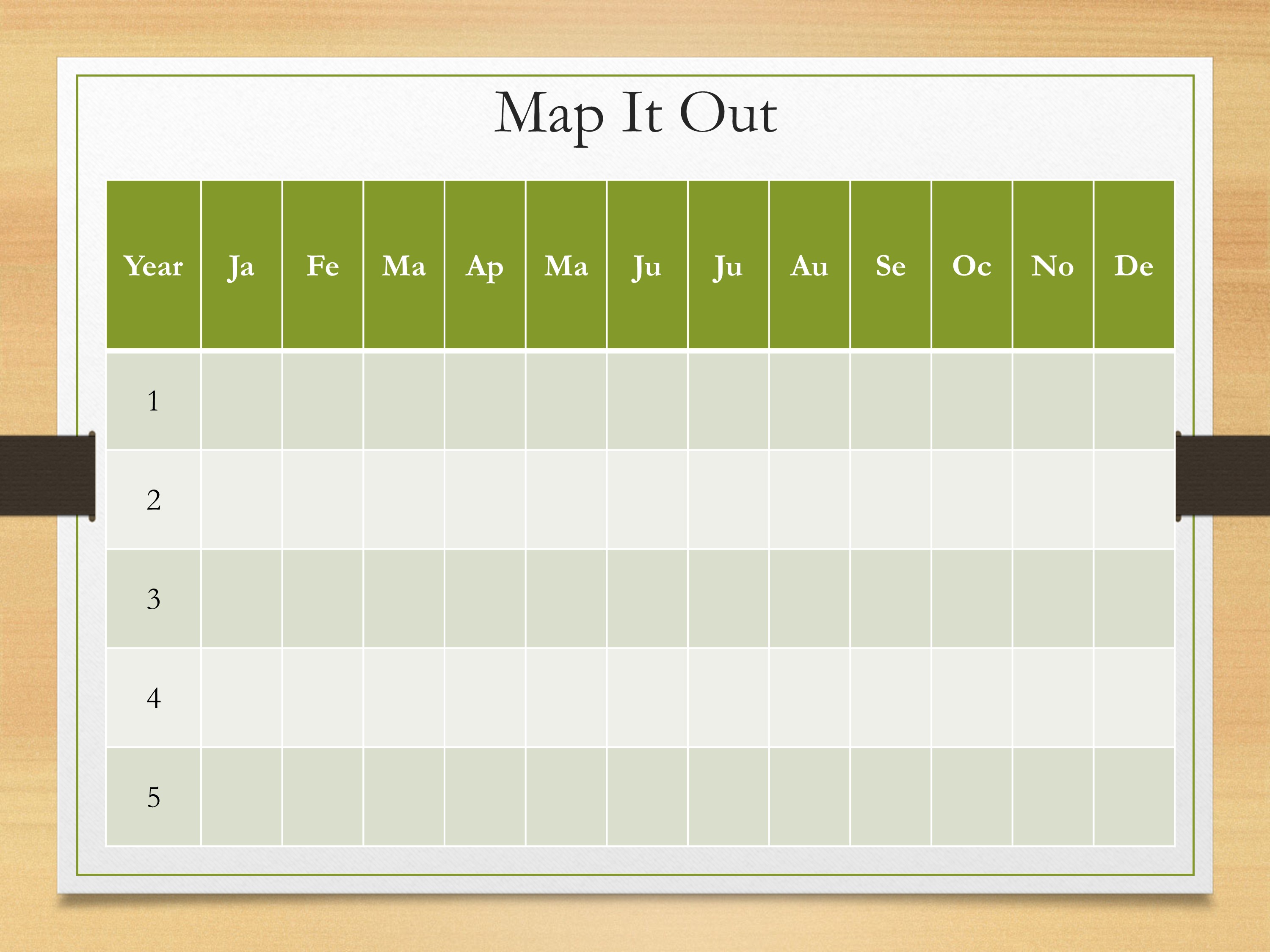
Let’s talk about mapping it out. You have your long-term goal. You have your short-term goals. You’re breaking it down thinking about all those little steps that you need to accomplish. We gotta put it on a calendar. When is it going to happen?
This is an example—you might have your five years. Each month plugging in what are you going to accomplish by that time. Maybe it’s when are grant applications due? It’s going to be important to put those on there to go what do I need to do to make that deadline. Maybe it’s putting when you’re going to get publications out. Things like that.
Honestly, looking at this drives me a little bit crazy, it seems a bit overwhelming. But it’s important to get to these details.

This is an example from, I did Lessons for Success a few years ago and they had their format for doing your plan. I wrote out all my projects, started thinking about all the different aspects. So if something like this works for you, by all means you could use that type of procedure.
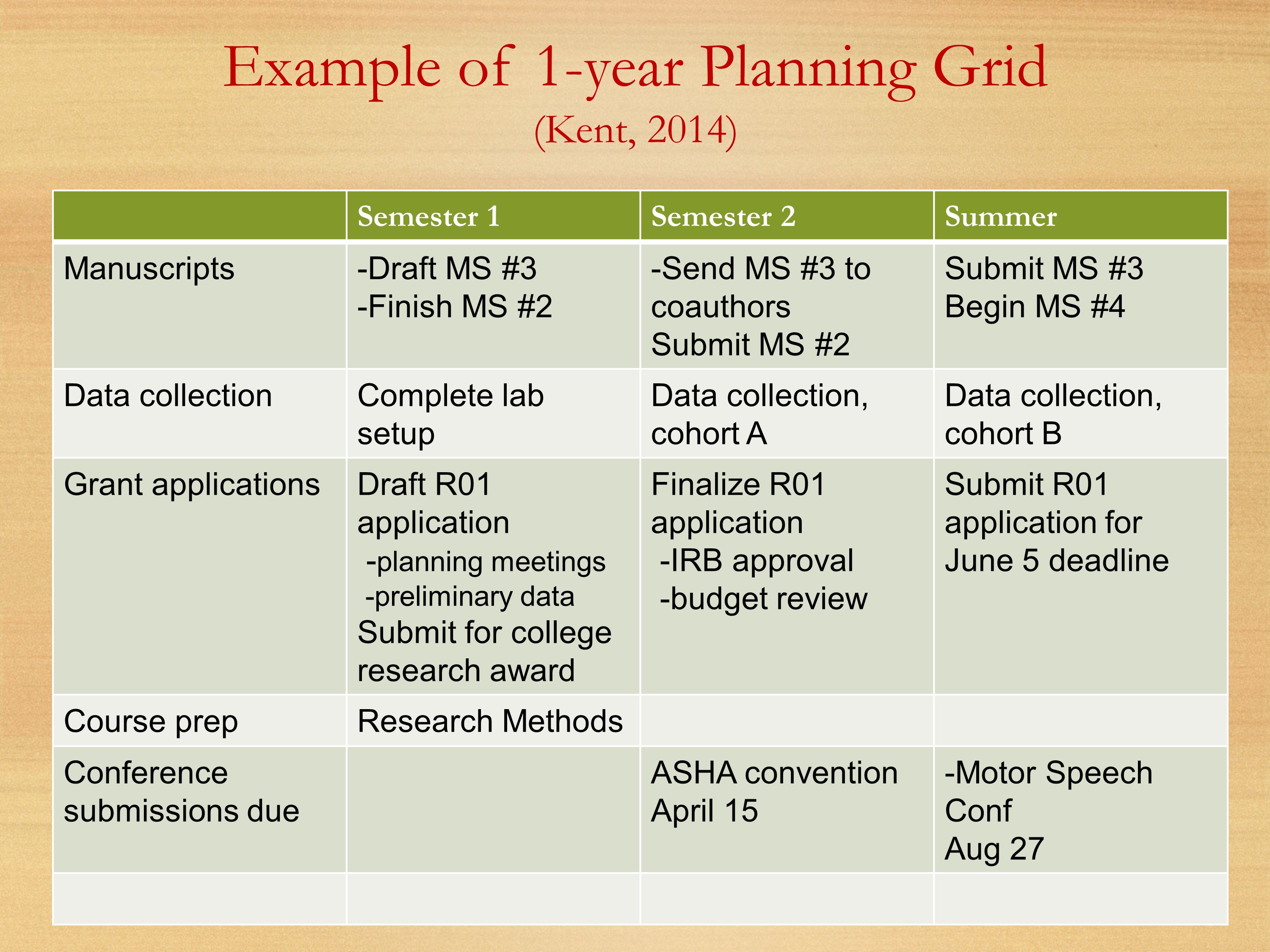
Here’s a grid that Ray Kent showed last year. We’re breaking it down by semester. Thinking about each of your semesters, what manuscripts you’re going to be working on, what data collection, your grant applications. Starting to get into some of those other buckets: course preparation,
conference submissions.

We also need to include teaching and service.
You probably can’t see this very well. This is similar to that last slide Ray Kent had used last year.
I have my five year plan: what studies I want to accomplish, start thinking about breaking it down.
Then at the beginning of each semester, I fill in a grid like this. Where at the top, I have each of my buckets. I have my grant bucket, my writing bucket which is going to include publications. I also include doing article reviews in my writing bucket, because that’s my writing time. My teaching bucket, my research bucket. Then at the end, my service bucket.
At the beginning of the semester, I think about the big things I want to accomplish. I list those at the top. Then at the beginning of each month, I say, okay what are the things I’m going to accomplish this month, write those in. Then at the beginning of each week, I start looking at whether I’m dedicating any time to the things I said I was going to do that month.
I start listing those out saying, this is the amount of time I’m going to spend on that. Of course, I have to take data on what I actually do, so I plug in how much time I’m spending on each of the tasks. Then I graph it, because that’s rewarding to see how much time you’re spending on things, and I get a little side-tracked sometimes.
Think about a system that will help you keep on track, to make sure you’re meeting the goals that you want to meet in terms of your research. But also getting the other things done that you need to get done in terms of teaching and service.
Discussion and Questions
Compiled from comments made during the Pathways 2014 and 2015 conferences. (Video unavailable.)
Building Flexibility into Your Five-Year Plan
Comments by Ray Kent, University of Wisconsin-Madison
The five-year plan is not a contract. It’s a map or a compass. A general set of directions to help you plan ahead. It’s not even a contract with yourself, because it will inevitably be revised in some ways.
Sometimes cool things land in your lap. Very often it turns out that through serendipity or whatever else, you find opportunities that are very enticing. Some of those can be path to an entirely new line of research. Some of them can be a huge distraction and a waste of time. It’s a really cool part of science that new things come along. If we put on blinders and say, “I’m committed to my research plan,” and we don’t look to the left or the right, we’re really robbing ourselves of much of the richness of the scientific life. Science is full of surprises, and sometimes those surprises are going to appear as research projects. The problem is you don’t want to redirect all your time and resources to those until you’re really sure they are going to pay off. I personally believe, some of those high risk but really appealing projects are things you can nurse along. You can devote some time and build some collaborations – far enough to determine how realistic and viable they are. That’s important because those things can be the core of your next research program.
It’s very easy to get overcommitted. We all know people who always say “yes”—and we know those people, and they are often disappointing because they can’t get things done. It’s important to have new directions, but limit them. Don’t say, “I’m going to have 12 new directions this year.” Maybe one or two. Weigh them carefully. Talk about them with other people to get a judgment about how difficult it might be to implement them. It enriches science: not only our knowledge, but the way we acquire new knowledge. A psychologist, George Miller—this is the guy with the magic number 7 +- 2—when we interviewed him years ago at Boystown, he said, “My conviction is that everybody should be able to learn a new area of study within three months.” That’s what he thought for a scientist was a goal.
The idea is that you can learn new things. And that’s very important because when you think of it in terms of a 30-year career, how likely is it that the project that you’re undertaking at age 28 is the same project you’ll be working on at age 68? Not very likely. You’re going to be reinventing yourself as a scientist. And reinventing yourself is one of the most important things you can do, because otherwise you’re going to be dead wood. Some projects aren’t worth carrying beyond five or ten years. They have an expiration date.
Building Risk into Your Five-Year Plan
Comments by Ray Kent, University of Wisconsin-Madison
Your doctoral study should generally be low-risk research. As you move into a postdoctoral fellowship, think about having two studies—one low-risk, one high-risk with a potential for high impact. At this time you can begin to play the risk factor a little bit differently.
When you are tenure-track you can have a mix of significance with low-risk and high-risk studies. And when you are tenured, then you can go for high risk, clinical trials, and collaborations. Because you have established your independence, so you do not need to worry about losing your visibility. You can be recognized as a legitimate member of the team.
As you plan your career, you should take risk into account. Just as you manage your money taking risk into account, we should manage our careers taking risk into account. I have met people who did not really think about that, and they embarked on some very risky procedures and wasted a lot of time and resources with very little to show for it. For example, don’t put everything into an untested technology basket. You want to be using state of the art technology, but you want to be sure it is going to give you what you need.
Other Formats and Uses of Your Research Plan
Audience Comments
- If you do your job right with your job talk, there’s a lot of cross-pollination between your job talk and your research plan. Ideally your job talk tells your colleagues that this is the long-term plan that you have. And they shouldn’t be surprised when you submit a more detailed research plan. They should say, “okay this is very consistent with the job talk.” In my view, the job talk should be a crystal summary of the major aspects of that research program. Of course, much of the talk will be about a specific project or two—but it should always be embedded within the larger program. That helps the audience keep sight of the fact that you are looking at the program. You can say that this is one project that I’ve done, and I plan to do more of these, and this is how they are conceptually related. That’s a good example of why the research plan has multiple purposes – it can be a research statement, it can be the core of your job talk, it can be the nature of your elevator message, and it can be a version of your research plan for a K award application or R01 application or anything else of that nature.
- I think what’s useful is to actually draft your NIH biosketch. The new biosketch has a section called “contributions to science.” It’s really helpful to think about all your projects. It’s hard to start with a blank sheet of paper. But to have it in the format of a biosketch can be really helpful.
Avoiding Overcommitment
Audience Comments
- One of the things that is amazing about planning is that if you put an estimate on the level of effort for each part of your plan, you’ll quickly find that you are living three or four lives. Some 300% of your time is spent. It’s helpful for those of us who might share my lack of ability to see constraints or limitations to reel it back and say, “I have a lot on my plate.” Which allows you to say no—which is not something we all do very well when it comes to those nice colleagues and those people you want to impress nationally and connect with. But it allows you to look at what’s planned and go, “I don’t know where I’d find the time to do that.” Which will hopefully help you stay on track.
- I keep a to do list, but I also keep a “to not do” list. One of the things I will keep on my plan is the maximum number of papers I will review in a year. If I hit that number in March, that’s it. I say no to every other paper that comes down the pike. That’s something to work out with your mentor as far as what’s realistic and what’s okay for you. Every time I get a request, I think, “That’s my reading and writing time, so what am I willing to give up. If it means I won’t be able to write on my own paper this week, am I willing to do this?”
Staying on Schedule with Reading, Writing, and Reviewing
Audience Comments
- You have to do what works for you. Some people do wait for big blocks of time for writing—which are hard to come by. But the most important thing is to block off your time. Put it on your schedule, or it is the first thing that will get pushed aside.
- Another thing I’ve done with some of my colleagues is writing retreats. So maybe once a year, twice a year, we’ll get together. Usually we’ll go to a hotel or somewhere, and we’re just writing. It’s a great way to get a jumpstart on a project. Like, I need to sit down and start this manuscript, and you can keep going once you’ve got that momentum.
- My input would be that you really have to write all the time, every day. It’s a skill. I’ve found that if I take time off, my writing deteriorates. It’s something you need to keep up with.
- I would look at it like a savings account that you put money into on a daily, weekly, monthly basis. The flip side of writing is reading. I would read constantly, widely, and not just in the discipline. That will give you not only a breadth in terms of your understanding of your field and the world around you, but it will also give you an incentive to make your own contributions. I think we don’t talk enough about the comprehensive side to this, and being receptive to the reading. I have a book, or something, by my bedside every night. And I read that until I fall asleep every night. And it’s done me in good stead over the years.
- Reviewing articles can help advance your career, but it is something you need to weigh carefully as a draw on your time. You get a lot from it. You get to see what’s out there. You get to see what’s coming down the pipe before publication. To me that’s a huge benefit. You get to learn from other people’s writing, and that’s part of your reading you get to do. But it is time consuming. And it depends on the kinds of papers you get. Sometimes you’re lucky and sometimes you’re not.
- If someone else is reviewing your grants and your articles, at some point you owe it back. You should at least be in break-even mode. Now, pre-tenure or postdoc your mentor should be doing that or senior faculty in the department. But there are so many articles to review. I review so many articles, but I am also at the tail end of my career. The bottom line is, if you don’t put on your schedule that if you don’t put time on your schedule for reading, reviewing articles forces you to look at and think about the literature, so you can be accomplishing what you owe back to the field—and at the same time, staying one step ahead knowledge wise. It forces you to do what you should be doing all along, which is keeping up with the literature.
Further Reading: Web Resources
Golash-Boza, T. (2014). In Response to Popular Demand, More on the 5-Year Plan. The Professor Is In. Available at http://theprofessorisin.com/2014/05/09/in-response-to-popular-demand-more-on-the-5-year-plan
Kelsky, K. (2010). The Five-Year Plan for Tenure-Track Professors. Get a life, PhD. Available at http://getalifephd.blogspot.com/2010/07/five-year-plan-for-tenure-track.html
National Association of Geoscience Teachers (NAGT). (2012). Planning Worksheets. Planning your Research Program (Available from the Science Education Resource Center at Carelton College Website at http://serc.carleton.edu/).
Pfirman, S., Bell, R., Culligan, P., Balsam, P. & Laird, J. (2008). Maximizing Productivity and Recognition, Part 3: Developing a Research Plan. Science Careers. Available at http://sciencecareers.sciencemag.org/career_magazine/previous_issues/articles/2008_10_10/caredit.a0800148
Weber, R. J. & Cobaugh, D. J. (2008). Developing and executing an effective research plan. American Journal of Health-System Pharmacy, 65(21), 2058–2065 [Article] [PubMed]





